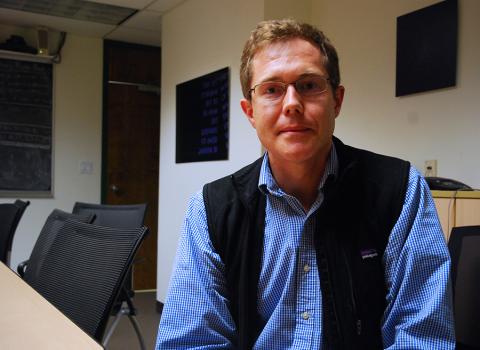
Dr. Richard Hill, assistant professor of theoretical particle physics at the University of Chicago and distinguished visiting scientist at TRIUMF, is dedicated to bringing law and order to physics problems through the simplicity of mathematics. For the duration of his stay at TRIUMF, Hill will be collaborating with individuals who share his commitment to discovering new ways of understanding the world.
A mathematician in his early years, Hill studied a combination of math and physics throughout his undergraduate career before eventually committing to physics. “I enjoyed thinking about numbers," he explains. “I wanted to connect numbers with the real world, so physics was the natural goal.”
Hill continues to use his talents in pattern-recognition, detailing calculations, and interpreting data in order to unravel the biggest mysteries facing today’s generation of physicists, both in Canada and across the world.
Hill’s year long visit is jointly hosted by TRIUMF and Perimeter Institute, where he will be spending a third of his time. This may be Hill’s first extended stay at TRIUMF but with such overlap in research interests, it is certainly a natural place for him to visit. “TRIUMF has a very broad research program, and I’m still finding new things that people are doing,” he says. “It’s clear that there’s a lot of expertise just at TRIUMF itself, and there are really world leading people and experiments; for example, many of the measurements being done in muons, neutrinos and other precision measurements.”
As a part of the theory group at TRIUMF, Hill is concerned with three research topics, all connected to global physics experiments.
One area of his focus is the particle that was the subject of the 2015 Nobel Prize in physics – the neutrino. “There are still some properties of neutrinos that we still don’t understand,” he says. “These include really basic questions like whether a quantity called lepton number is conserved in neutrino interactions, and whether a fundamental symmetry called CP symmetry is conserved.” According to Hill, these questions will likely be answered by next generation experiments with global collaborations, hosted at places like SNOLAB in Sudbury, Ontario and J-PARC in Japan.
In order to perform and interpret these experiments, however, the basic properties of neutrino interaction need to be understood better. This means making detailed calculations important for distinguishing the different types of neutrinos that appear in the detector and then being able to translate those to the underlying neutrino parameters. Hill’s research in this area overlaps with TRIUMF’s connections to the Tokai to Kamioka (T2K) experiment in Japan, which sends an intense neutrino beam 295 km across the island to a detector called Super Kamiokande, located in an underground mine.
Another area of Hill’s research with connections to neutrino interactions is the proton radius puzzle – a problem that has been discussed since 2010 when a paper published in Nature revealed that the proton was smaller than originally thought. Hill has spent some time thinking about this puzzle, as have others in the Theory Group here at TRIUMF.
Hill is also interested in dark matter interactions. “One aspect of this is that the non-observation of new physics so far at the Large Hadron Collider (LHC) has pushed us into a regime where the particles beyond the Standard Model might be a bit heavier than we thought.” With this in mind, Hill and collaborators from TRIUMF, the University of Chicago, and Perimeter Institute have developed a new way of analyzing interactions of dark matter with nuclei. Their predictions have indicated that bigger detectors may be needed. “We’re trying to refine those calculations to see exactly how big those detectors would need to be, and this would connect with some of the experiments at SNOLAB like the DEAP experiment.”
Thus far, his stay has been a positive experience – one full of connections to research being done nationally and globally, which is what drew him to the field in the first place. For Hill, the best part about being a physicist is what the field offers by way of understanding the world. “I think it’s the idea of discovery,” he says. “The idea of one day not knowing, and the next day knowing something true about the world.”
-Carla Rodrigo, Communications Assistant
